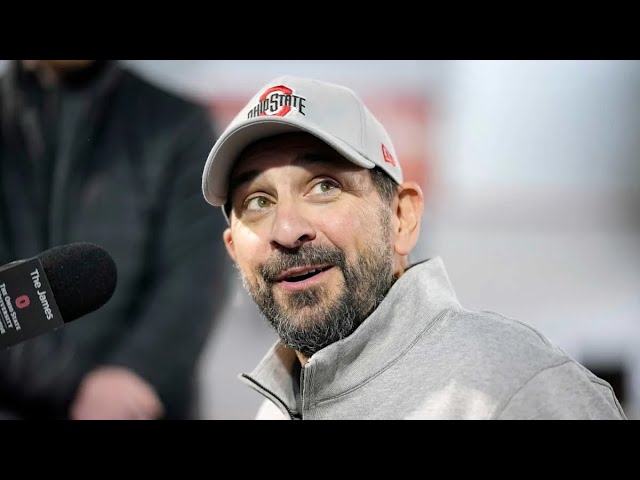When Ohio State hired Matt Patricia as its new defensive coordinator following Jim Knowles’ departure to Penn State, it signaled a significant philosophical shift for the Buckeyes‘ defense. Patricia, a three-time Super Bowl champion with the New England Patriots and former Detroit Lionshead coach, brings a wealth of NFL experience and a sophisticated defensive mindset to Columbus. As the Buckeyes look to defend their national championship, understanding Patricia’s defensive philosophy provides insight into how Ohio State’s defense might evolve in 2025.
The Foundations of Patricia’s Defensive Approach
At its core, Matt Patricia’s defensive philosophy is built on adaptability and tailoring schemes to player strengths. During his introductory press conference, Patricia emphasized this foundational principle: “My whole goal is to try to figure out what you do well. How do I put you in the best position to go get on the field and do that job well to the best of your ability?”
This player-first approach was refined during his time with the Patriots, where circumstances forced evolution. “When I originally went to New England in the early 2000s, the game was different,” Patricia explained. “We were fundamentally a 3-4 team, as people would say. Now our 3-4 has changed through the years.”
Patricia’s defense is known for its multiplicity—the ability to present various fronts and coverage schemes from week to week, often tailored specifically to counter an opponent’s strengths. This adaptability helps explain why early spring practices have shown both 4-2-5 alignments (similar to last year’s defense under Knowles) alongside potential 3-4 and 3-3-5 packages.
Multiple Fronts for Multiple Situations
Unlike some coordinators who rigidly adhere to a specific system, Patricia has demonstrated mastery across various defensive alignments. “I’ve coached all of it,” he noted. “I’ve coached 3-4, 4-3, nickel, big nickel, dimes, all those packages, four down fronts, five down fronts, odds facing.”
Early observations from Ohio State’s spring practices reveal that while Patricia is keeping the 4-2-5 as the base defense (with Sonny Styles and Arvell Reese as first-team linebackers), he’s likely to implement more 3-4 elements than Buckeyes fans have seen in recent years. This approach allows Patricia to utilize Ohio State’s defensive personnel in multiple ways:
- Players like C.J. Hicks, who has moved from linebacker to defensive end, can be deployed as traditional defensive ends or stand-up edge rushers depending on the situation
- Versatile defenders like Sonny Styles, who began his career as a safety before moving to linebacker, can be employed in various roles
- The defensive line, featuring Kenyatta Jackson Jr., Eddrick Houston, and Kayden McDonald, will likely see more stunts and twists than under previous schemes
A key component of Patricia’s defensive philosophy is his approach to the passing game. According to one college football analyst, “Patricia bases his defense off of the pass game and specifically the pass rush.” This emphasis translates to advanced stunts in interior gaps designed to free up edge rushers for clean shots at opposing quarterbacks.
Patricia’s Secondary Approach
In the secondary, observers can expect to see more robber coverages and Cover 3/Cover 5 matchups than in previous systems. These coverage schemes are designed to force quarterbacks to throw into tight windows on underneath routes while defenders read and react to passing plays.
With star safety Caleb Downs returning, Patricia has a versatile chess piece around whom he can build his secondary. “He is an unbelievable, amazing player, very versatile,” Patricia said of Downs. “You look at a guy like that and you think, we’re going to be able to do some really fun things with him.”
Patricia has previously utilized versatile safeties as hybrid safety/linebacker defenders—something Ohio State already began implementing with Downs late last season. This approach allows the defense to disguise coverages and confuse quarterbacks about whether a play will face zone or man coverage.
The cornerback position will see Davison Igbinosun and Jermaine Mathews Jr. as likely starters, with Lorenzo Styles Jr. handling nickel duties. However, Patricia’s system may incorporate more personnel variation in the secondary than Ohio State employed last year, potentially utilizing three-cornerback or three-safety looks depending on the opponent and situation.
Adapting NFL Concepts to College Football
One significant question surrounding Patricia’s appointment is how effectively he can translate his NFL defensive concepts to the college game. NFL defenses benefit from more practice time, veteran players, and the ability to implement complex weekly game plans—luxuries not always available in collegiate football.
Patricia seems aware of this challenge, emphasizing simplicity so players can play fast. While his Patriots defenses were known for their complexity, his approach at Ohio State appears focused on teaching fundamentals while gradually implementing his system’s more sophisticated elements.
“We would always morph the defense based on the talent we had,” Patricia said, referring to his NFL coaching experience. “Personnel was always the biggest thing: Who do we got? Who are the best 11 guys we can put on the field to help us win this week, and who do they got?”
The Focus on Disruption and Pressure
Perhaps the most distinctive element of Patricia’s defensive approach is its proactive, disruptive nature. Analysts describe his defenses as “offensive” and “proactive,” constantly seeking to pressure quarterbacks and attack the football.
This aggressive mindset manifests in several ways:
